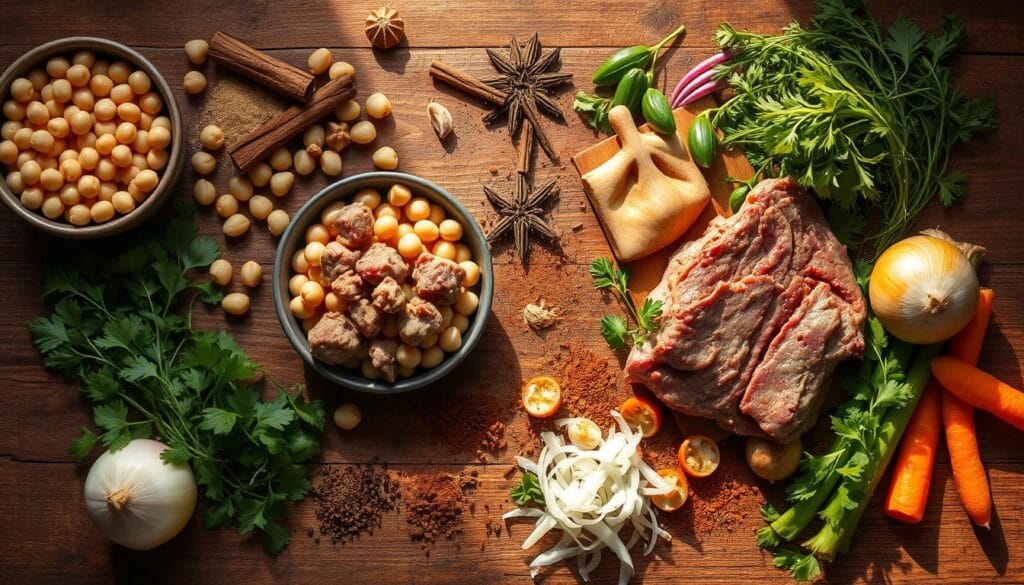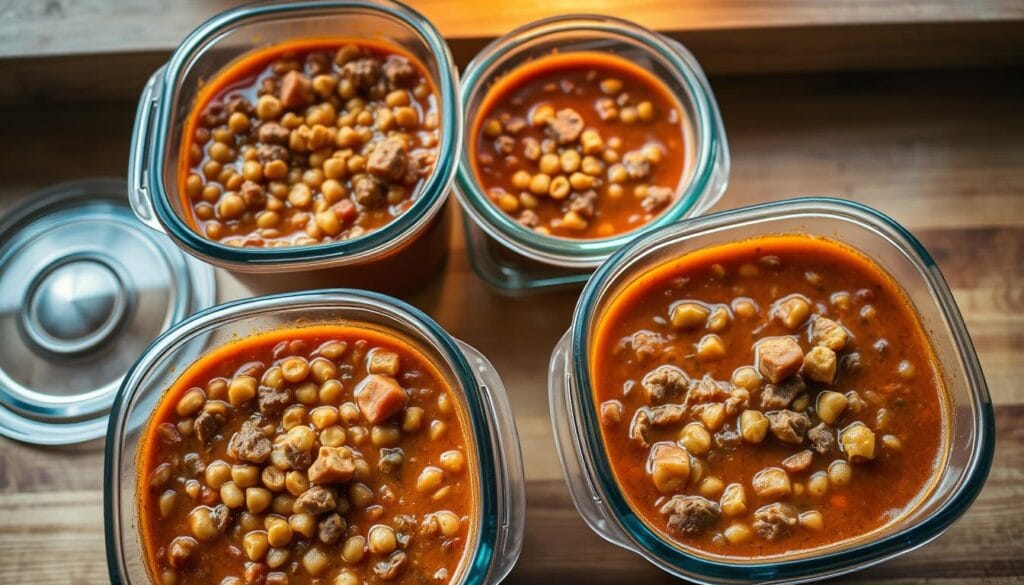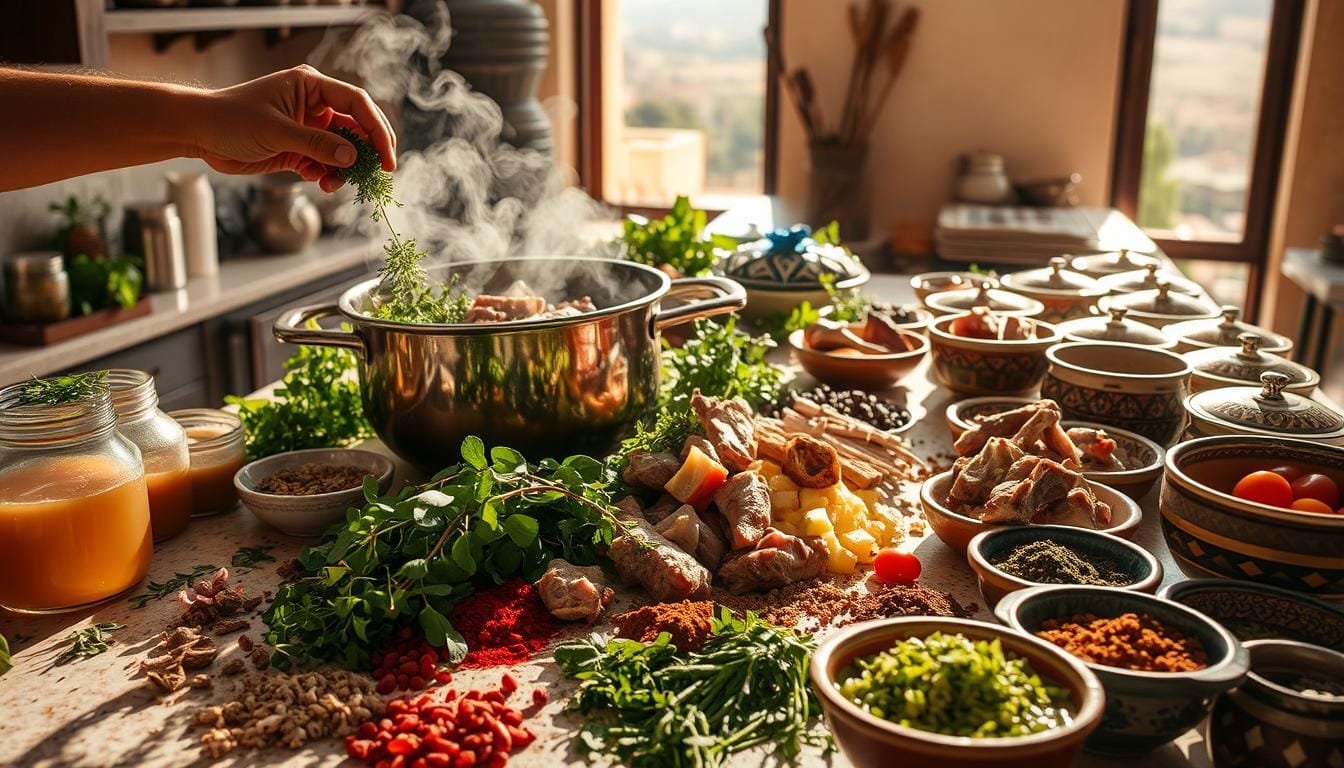On a crisp evening, the smell of spices fills my kitchen. It takes me to the lively streets of Morocco. Moroccan Harira soup is more than a meal. It’s a journey that connects generations and cultures through its rich flavors.
This beloved Moroccan dish is not just a soup. Harira is a deep culinary tradition that links taste and cultural heritage. If you’re looking for a hearty meal or want to try international cooking, this Moroccan harira soup offers a real experience. It warms both your body and soul.
Harira is packed with tomatoes, lentils, chickpeas, and spices. It turns simple ingredients into a stunning dish. You can enjoy it as an appetizer or main course. Its flexibility makes it great for different diets, whether you eat meat or prefer vegetables.
Table of Contents
Understanding the Cultural Significance of Harira Soup
Harira is more than a soup; it’s a journey into Moroccan culture and hospitality. This iconic soup is not just a meal. It carries centuries of heritage and social bonds.
The name “harira” means “silk” in Arabic, showing its smooth texture. Dr. Lotfi Zghari says it’s key for quick energy during Ramadan.
Origins and Traditional Uses
Harira’s history is rich, starting as a simple dish to a cultural icon. Its making shows Morocco’s diverse cuisine, with each area adding its twist.
- Started as food for workers and travelers
- Now symbolizes hospitality and community
- Highlights Morocco’s complex food heritage
The Role of Harira During Ramadan
In Ramadan, harira becomes a spiritual ritual. Moroccan families enjoy it every day, breaking their fast with its nutritious mix.
| Nutritional Aspect | Value per Serving |
|---|---|
| Protein | 18g |
| Calories | 431 |
| Carbohydrates | 71g |
| Dietary Fiber | 15g |
Regional Variations Across Morocco
Every Moroccan region has its own harira. Marrakech’s is rich with tomatoes, while desert areas focus on protein. Coastal areas add fish and sea herbs, showing the variety of ingredients.
- Marrakech Style: Thick with saffron and ginger
- Desert Region: Rich in dried legumes
- Coastal Interpretation: Includes fish and sea herbs
Harira is more than a Ramadan soup. It showcases Moroccan culinary skill, nutrition, and identity.
Essential Ingredients for Moroccan Harira Soup
To make a true north African soup like Harira, you need the right ingredients. They add depth and traditional flavor to your dish. Your moroccan lentil soup will be amazing with the perfect mix of fresh produce, proteins, and spices.
Primary Ingredients
- Fresh Tomatoes: 6 large tomatoes, peeled and pureed
- Legumes:
- 3/4 cup dried chickpeas (soaked overnight)
- 3 tablespoons dried lentils
- Protein: 1/2 pound lamb, beef, or chicken (cut into 1/2-inch pieces)
- Olive oil: 2 tablespoons
The magic of this north African soup is in its mix of ingredients. Each part is key to the soup’s rich, complex taste.
Key Spices and Herbs
- Garlic: 4 cloves, minced
- Fresh herbs:
- 1/4 cup fresh cilantro
- 1/4 cup fresh parsley
- Traditional Moroccan spice blend
“The secret to an authentic Harira is balancing spices and allowing ingredients to tell their story.” – Moroccan Culinary Tradition
Nutritional Breakdown
| Nutrient | Per Serving |
|---|---|
| Calories | 268 kcal |
| Protein | 13 g |
| Carbohydrates | 43 g |
| Fiber | 13 g |
Whether you’re making a vegetarian version or sticking to the traditional recipe, these ingredients will make your moroccan lentil soup a culinary masterpiece. It will take you straight to the lively streets of North Africa.
Kitchen Equipment and Tools You’ll Need
To make a traditional Moroccan soup like Harira, you need the right kitchen tools. Whether you’re experienced or new to cooking, the right equipment makes the process easier and more fun.
- Large stockpot (minimum 6-quart capacity)
- Pressure cooker
- Sharp chef’s knife
- Cutting board
- Wooden spoon
- Measuring cups and spoons
- Immersion blender (optional)
Traditional Cooking Methods
In traditional Moroccan cooking, soups were made in large pots over an open flame or charcoal. This slow cooking method is key for developing deep, rich flavors.
Pressure Cooker vs Stockpot Options
Today, you can choose between two main ways to cook Harira:
| Cooking Method | Cooking Time | Flavor Intensity |
|---|---|---|
| Traditional Stockpot | 2-3 hours | Deep, complex flavors |
| Pressure Cooker | 45-60 minutes | Rich, concentrated taste |
The pressure cooker cuts down cooking time but keeps the essence of traditional moroccan soup. It’s perfect for those who want authentic flavors without long hours in the kitchen.
Decide between a stockpot or pressure cooker based on your schedule and what you have. Both methods can lead to tasty results if you know the basics of Moroccan cooking.
Preparing the Base Ingredients
Making a real spiced tomato soup begins with preparing your base ingredients well. The key to a tasty Moroccan harira soup is in how you chop and blend your veggies.
- Wash and clean fresh herbs thoroughly
- Remove stems from cilantro and parsley
- Chop celery into small, uniform pieces
- Peel and seed ripe tomatoes
To make a great Moroccan harira soup, blend your veggies in a food processor. Use 1 large onion, 2 celery stalks, and 2 large tomatoes. This mix gives your soup a rich, deep flavor.
“The secret to an exceptional harira lies in the careful preparation of your base ingredients.” – Moroccan Culinary Tradition
Blending is key for the right texture. Blend your herbs and veggies until they’re smooth. This way, every spoonful of your Moroccan harira soup will have the perfect mix of flavors.
It takes about 20 minutes to prepare this base. Spending time on these steps will help you make a hearty, flavorful soup that truly represents Moroccan cuisine.
The Perfect Spice Blend for Authentic Harira
Making the perfect spice blend is key to a true Moroccan cuisine experience. The right mix of spices turns a simple tomato soup into a rich, aromatic dish. It captures the heart of traditional Moroccan cooking.
Getting the spice balance right is essential for a remarkable flavor. Moroccan cooking uses a special mix of ground spices. These spices add depth and complexity to the dish.
Essential Spice Measurements
- Ground cumin: 2 teaspoons (6 grams)
- Smoked paprika: 1 teaspoon (2.3 grams)
- Ground cinnamon: 1/4 teaspoon (0.75 grams)
- Ground ginger: 1 1/2 teaspoons (7.5 grams)
- Ground turmeric: 1/2 teaspoon (1.5 grams)
- Black pepper: 1/2 teaspoon (1.5 grams)
- Cayenne pepper: 1/4 to 1/2 teaspoon (0.5 to 1.5 grams)
Understanding Flavor Interactions
Each spice has its own role in your harira’s flavor. Cumin gives it an earthy taste, while paprika adds a smoky touch. Cinnamon adds warmth, ginger brings heat, and turmeric gives it a golden color.
Spice Blend Storage Tips
To keep your spice blend fresh, store it in an airtight container. Keep it away from sunlight and heat. Whole spices last 3-4 years, and ground spices 1-2 years. Mark the container with the date to know when it was made.
Mastering this spice blend will make your harira a true Moroccan delight. It will impress your taste buds.
Step-by-Step Cooking Process
Making a traditional Moroccan soup needs care and focus. The harira soup cooking starts with getting your ingredients ready. Then, choose the right cooking methods to get deep, rich flavors.
Begin by warming 2 tablespoons of olive oil in a big pot over medium heat. The secret to a tasty Moroccan harira soup is starting with layers of flavor.
- Add diced onions and celery
- Sauté for about 5 minutes until they’re soft
- Stir in your special spice mix
Your spice mix is key for a true taste. Use 1 1/2 teaspoons ground ginger, 1/2 teaspoon black pepper, 1/2 teaspoon turmeric, 2 teaspoons cumin, and 1 teaspoon smoked paprika. A little saffron can make the flavor even better.
“The magic of Moroccan harira soup lies in its carefully balanced spices and slow-cooking technique.”
Then, add your protein-rich legumes. Include:
- 1/2 cup red lentils
- 1/2 cup brown or green lentils
- 1 1/2 cups cooked chickpeas
Pour 6 cups of water or vegetable broth into the pot. Let it boil, then lower the heat and simmer for about 30 minutes. In the last 10 minutes, add 1/4 pound of capellini pasta broken into 1-inch pieces.
To get the soup thick, mix flour and water to thicken it in the last 10-15 minutes. Finish by adding fresh herbs like 1/2 cup each of chopped cilantro and parsley.
Moroccan Harira Soup: The Traditional Method
Making authentic Moroccan lentil soup takes patience and knowing traditional cooking. It’s about layering flavors and following old methods passed down through generations.
Sautéing and Layering Flavors
Start by heating 2 tablespoons of olive oil in a big pot. The key to rich flavors is in sautéing right. Put in diced onions, celery, and minced garlic. Cook for about 5 minutes until they smell good and look a bit soft.
- Heat olive oil on medium heat
- Sauté onions, celery, and garlic
- Cook for 5 minutes until softened
Adding Legumes and Vegetables
Now, add the special ingredients to your soup. Put in 1 cup of dried brown lentils and 1 can of chickpeas with the veggies. Then, add 6 cups of vegetable broth to mix everything well.
Simmering Techniques
Turn up the heat to boil the soup, then lower it to a gentle simmer. Cover the pot and let it cook for about 45 minutes. This slow cooking makes the lentils tender and the flavors deep.
- Bring soup to a boil
- Reduce heat to low
- Simmer covered for 45 minutes
- Check lentil tenderness
The result is a hearty, nutritious soup that shows off Moroccan cuisine’s tradition. Every spoonful shares a story of heritage and careful making.
Mastering the Soup’s Texture and Consistency
Creating the perfect texture for your traditional Moroccan soup is key. It’s all about finding the right balance between liquid and solid. This balance turns a simple dish into a true masterpiece.
When making Moroccan harira soup, watch how thick it gets. You want it to be hearty but smooth. Here are some tips to get it just right:
- Keep a pot of hot water nearby to adjust thickness
- Stir frequently to prevent ingredient separation
- Gradually add liquid or thickening agents
- Allow proper simmering time for ingredients to meld
Ingredients like legumes and tomato paste are important for texture. Legumes thicken the soup, while tomato paste adds depth. If it’s too thick, add hot water slowly. If it’s too thin, simmer it uncovered to thicken it up.
Professional chefs say knowing your ingredients is important. Chickpeas and lentils make the soup thicker as they cook. Keeping an eye on the heat and stirring often will give you a smooth, authentic Moroccan soup.
Adding Proteins and Legumes
Making a true Moroccan lentil soup needs the right proteins and legumes. The right mix will make your harira rich in nutrition and flavor. It’s what makes this traditional dish special.

When making your chickpea soup, choose high-quality proteins. They should match the rich spices of harira. Canned chickpeas are a quick choice. They save time by not needing soaking or precooking.
Selecting and Preparing Legumes
For a real lamb soup, consider these protein options:
- Lamb chunks (traditionally preferred)
- Chicken pieces
- Vegetarian protein alternatives like tofu
Cooking Times for Different Proteins
Each protein needs special cooking to be tender and flavorful:
| Protein | Cooking Time | Preparation Tip |
|---|---|---|
| Lamb | 45-60 minutes | Cut into small cubes |
| Chicken | 30-40 minutes | Dice into bite-sized pieces |
| Chickpeas | 20-25 minutes | Rinse canned chickpeas thoroughly |
| Lentils | 25 minutes | Sort and rinse before cooking |
Remember, patience is key for rich flavors in your Moroccan lentil soup. Slow cooking makes proteins tender and spice-rich.
The Art of Thickening Harira
Learning to thicken Moroccan soup is all about precision and skill. The texture of Harira makes it stand out from other soups. Getting the right consistency is key to a true Moroccan taste.
To get the perfect thickener, start with a simple step. Mix 1 cup of flour with 2 cups of water. This mix will turn your soup into a smooth, creamy dish. Here’s how to do it:
- Mix 1 cup of flour with 2 cups of water
- Whisk thoroughly to eliminate lumps
- Strain through a fine-mesh sieve if needed
- Gradually incorporate into the traditional moroccan soup
Professional chefs suggest other ways to thicken Harira. Some old-school methods include:
- Using beaten eggs for a silky finish
- Incorporating ground rice
- Adding pureed vegetables
When adding your thickener, stir constantly to avoid clumps. The trick is to be patient and gentle. You want a smooth, rich soup that captures the essence of Moroccan cooking.
Pro tip: Let your Harira rest for 15-20 minutes after thickening to allow flavors to meld perfectly.
Remember, practice makes perfect. Each time you make Harira, you’ll get better at it. You’ll learn more about this cherished Moroccan dish.
Incorporating Fresh Herbs and Garnishes
The final touch of any Moroccan cuisine masterpiece lies in its garnishing techniques. Fresh herbs transform a simple soup into an extraordinary culinary experience. This is true, even when preparing traditional Harira. Your cilantro garnish will elevate the soup’s flavor profile and visual appeal.
When selecting herbs for your Harira, focus on two primary ingredients that define authentic Moroccan flavor:
- Fresh cilantro – bright and citrusy
- Flat-leaf parsley – clean and crisp
Choosing the Best Herbs
Select herbs that are vibrant green, without wilting or yellowing. Wash them thoroughly under cold water and pat dry using paper towels. For the most intense flavor, chop herbs just before serving to preserve their essential oils.
Traditional Garnishing Techniques
In Moroccan cuisine, herb garnishing is an art form. Finely chop cilantro and parsley, allowing them to delicately float on top of the soup. Sprinkle approximately 2-3 tablespoons per serving for optimal flavor and presentation.
| Herb | Quantity | Flavor Profile |
|---|---|---|
| Cilantro | 2 tablespoons | Bright, citrusy |
| Parsley | 1-2 tablespoons | Fresh, clean |
Additional garnishing options include a squeeze of fresh lemon juice or a light dusting of paprika. These can enhance your Harira’s visual and taste experience.
Storage and Reheating Guidelines

Storing your traditional moroccan soup needs some care to keep its taste and texture great. You can store your moroccan harira soup in an airtight container in the fridge for up to 3 days. This way, you can enjoy it several times.
Freezing your harira soup? Here are some key tips:
- Cool the soup completely before storing
- Use freezer-safe containers with tight-fitting lids
- Leave some space at the top for expansion
- Remove vermicelli before freezing for best results
Pro tip: Freeze harira soup in individual portion sizes for easy reheating!
Reheating your traditional moroccan soup needs gentle warming to keep its texture right. Try these methods:
- Stovetop: Warm slowly over medium-low heat
- Microwave: Use 50% power and stir frequently
- Add a little water or broth if the soup seems too thick
“The secret to perfect harira is in its careful storage and gentle reheating.” – Moroccan Cooking Experts
For frozen harira, thaw it in the fridge overnight before reheating. When you’re ready to eat, add fresh vermicelli while it’s warming up. This keeps its texture perfect.
Traditional Serving Suggestions and Accompaniments
Serving Harira, a traditional Moroccan cuisine staple, is all about presentation. Your Ramadan soup experience isn’t complete without the perfect accompaniments. These enhance the flavors of this hearty dish.
Traditionally, Harira is served with a variety of delightful side items. These items complement its rich flavors:
- Fresh lemon wedges to squeeze over the soup
- Crusty bread for dipping
- Sweet chebakia (honey-rosewater pastry)
- Dates for breaking the fast
During Ramadan, this soup is a key part of iftar meals. Families gather around the table, eagerly waiting for the first spoonful after fasting. The mix of legumes, spices, and tender meat makes Harira more than just a meal. It’s a cherished cultural experience.
For an authentic touch, serve your Harira in deep bowls. Garnish with fresh chopped parsley or cilantro. Consider adding harissa paste for those who like an extra kick of flavor in their Moroccan cuisine.
Pro tip: Warm bread and a side of dates turn your Harira into a complete and satisfying meal.
Conclusion
Your journey through Moroccan harira soup shows the depth of traditional cuisine. This dish is more than food; it’s a cultural experience. It connects you to Moroccan cooking traditions for generations.
Harira soup is a mix of proteins, legumes, and spices. It’s a nutritious and tasty adventure for anyone who cooks at home.
Learning to make harira soup takes time and effort. It might seem hard, but each step adds flavor. This turns simple ingredients into a special meal.
By learning the techniques and following traditional methods, you can make a true harira. It will take your taste buds to Morocco’s lively food scene.
Cooking harira is more than just following a recipe. It’s about joining a culinary tradition. Whether it’s during Ramadan or a cozy evening, you’re part of a rich cultural practice.
Harira is not only delicious but also very healthy. It’s full of protein, vitamins, and antioxidants.
With time, you’ll get better at mixing spices and finding the right consistency. You’ll make a dish that truly celebrates Moroccan cuisine. Share it with friends and family to make unforgettable memories.
FAQ
What is Harira soup and why is it important in Moroccan cuisine?
Is Harira soup only eaten during Ramadan?
Can I make a vegetarian version of Harira soup?
What are the key spices used in authentic Harira soup?
How long does it take to prepare Harira soup?
How should I store leftover Harira soup?
What are typical accompaniments to serve with Harira?
Can I freeze Harira soup?
There are no reviews yet. Be the first one to write one.

